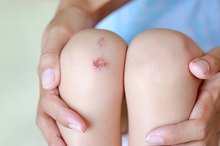What does fact checked mean?
At Healthfully, we strive to deliver objective content that is accurate and up-to-date. Our team periodically reviews articles in order to ensure content quality. The sources cited below consist of evidence from peer-reviewed journals, prominent medical organizations, academic associations, and government data.
The information contained on this site is for informational purposes only, and should not be used as a substitute for the advice of a professional health care provider. Please check with the appropriate physician regarding health questions and concerns. Although we strive to deliver accurate and up-to-date information, no guarantee to that effect is made.
How to Tell if You Have Scabies
Scabies is an infestation of a microscopic mite with eight legs called Sarcoptes scabiei that tunnels and lays its eggs in the skin. As the eggs mature and new mites emerge, they spread to other areas of the skin. The mite can infect others through close contact, such as sexual contact, or sharing clothes or bedding in families, schools, nursing homes or other group environments. Early diagnosis of scabies can ensure faster treatment and avoid further transmission of the condition.
Check for tracks on the skin. These narrow burrows consist of a series of very small bumps that can also appear as a rash, often in areas where your skin folds such as the armpits, the waist, inside the elbow or knees, between fingers, near the male genitals, under the breasts and on the feet or buttocks.
What Are Skin Symptoms of Mites?
Learn More
Notice if the areas itch. An allergic response occurs with severe itching due to the mites, the eggs and their waste products. The irritation and itching is often stronger when you try to sleep at night.
See your doctor. Other skin problems can also itch but the itching combined with the tunnel-like rash is a strong clue for scabies. Your doctor can confirm for sure. If visual verification isn't possible, he can take a sample from your skin for microscopic examination that can reveal the mites, their eggs or the scabies fecal matter.
Tips
To avoid scabies, don't share clothing or bedding with anyone who has the condition. Avoid close contact until the person has been treated and the infestation is gone.
Warnings
If you have scabies, avoid scratching the rash or burrows as much as possible. Breaking the skin could make you susceptible to a bacterial skin infection. Untreated, severe scabies can spread widely on the body, form a scaly crust and be extremely contagious and difficult to eradicate.
Related Articles
References
- Mayo Clinic
- Med TV
- Scabies. World Health Organization.. May 20, 2019.
- CDC - Scabies - Disease. Centers for Disease Control and Prevention. Nov 2, 2010.
- Harvard Health Publishing. Scabies. Harvard Health. Dec 2018.
- Mrázová Z, Jadrníčková I, Brabcová K, Spurný F. Fragmentation of Ne ions with energy 400 MeV/u behind targets from different materials measured with PNTD. Radiation Measurements. 2010;45(10):1438-1440. doi:10.1016/j.radmeas.2010.06.048.
- Patel VM, Lambert WC, Schwartz RA. Safety of Topical Medications for Scabies and Lice in Pregnancy. Indian J Dermatol. 2016;61(6):583-587. doi:10.4103/0019-5154.193659
- CDC - Scabies - Resources for Health Professionals - Medications. Centers for Disease Control and Prevention. Oct 2, 2019.
- CDC - Scabies - General Information - Frequently Asked Questions (FAQs). Centers for Disease Control and Prevention. Oct 24, 2018.
- Arlian LG, Morgan MS. A review of Sarcoptes scabiei: past, present and future. Parasit Vectors. 2017 Jun 20;10(1):297. doi: 10.1186/s13071-017-2234-1.
- CDC. Scabies. Resources for Health Professionals, Medications.
- Micali G, Lacarrubba F, Verzì AE, Chosidow O, Schwartz RA. Scabies: Advances in Noninvasive Diagnosis. PLoS Negl Trop Dis. 2016 Jun 16;10(6):e0004691. doi: 10.1371/journal.pntd.0004691. eCollection 2016 Jun.
Tips
- To avoid scabies, don't share clothing or bedding with anyone who has the condition. Avoid close contact until the person has been treated and the infestation is gone.
Warnings
- If you have scabies, avoid scratching the rash or burrows as much as possible. Breaking the skin could make you susceptible to a bacterial skin infection. Untreated, severe scabies can spread widely on the body, form a scaly crust and be extremely contagious and difficult to eradicate.
Writer Bio
Rosanne Knorr is an award-winning writer, editor and author since 1980. She has written feature articles for countless publications and has authored 13 books including "The Grown-Up's Guide to Running Away from Home." She ghostwrites books on financial and lifestyle topics. She has taught creative writing and speaks on writing and travel topics. Knorr holds a Bachelor of Arts in English.









